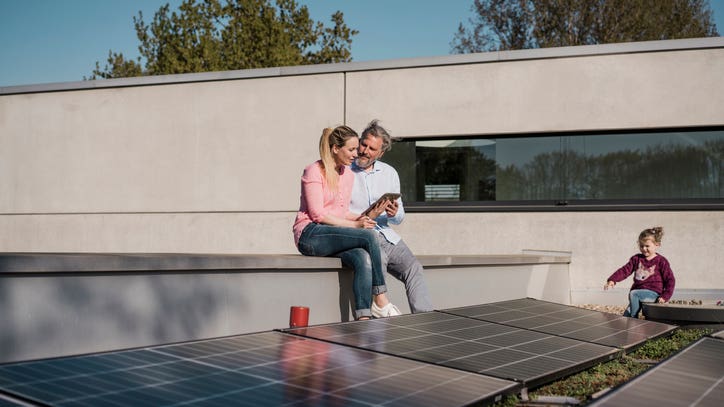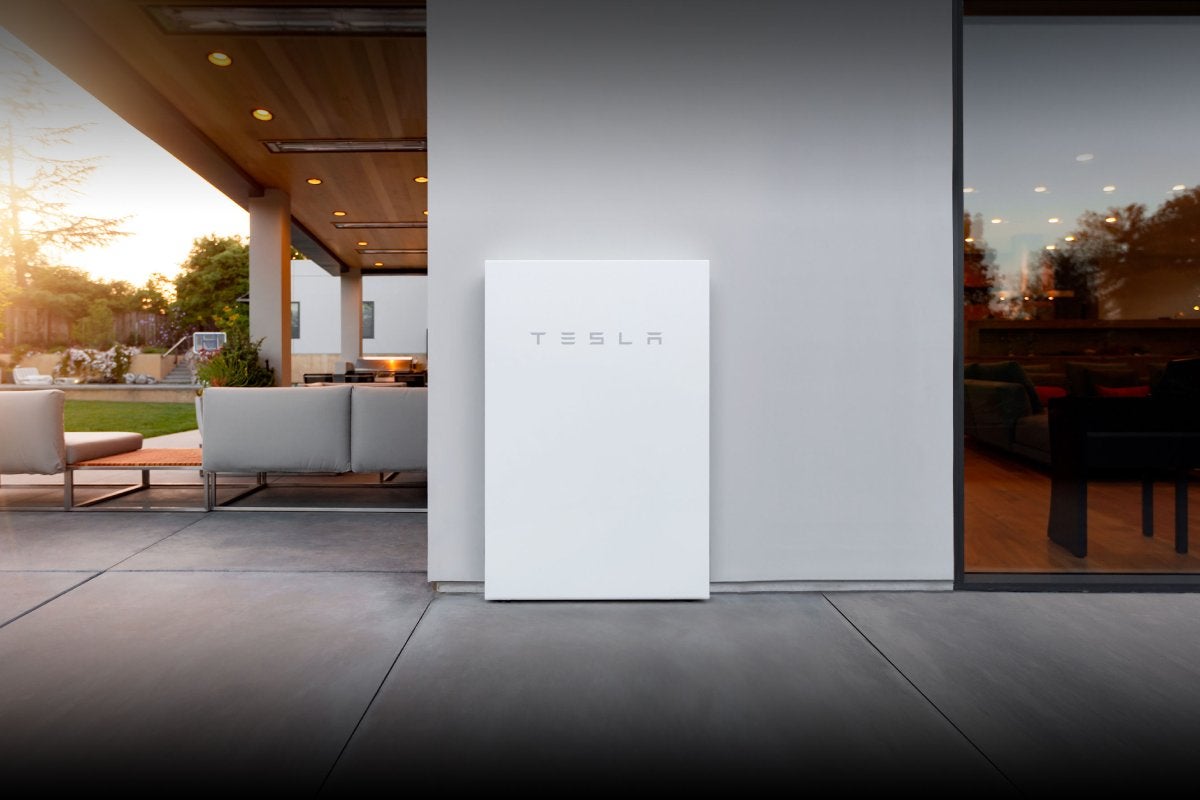How Much Do Solar Panels Cost In 2024?

Consider solar panels if you live in a state with high energy costs
Key takeaways
- The average solar panel system in 2024 costs about $31,558 before factoring in tax credits and solar incentives.
- The Residential Clean Energy Credit is part of the Inflation Reduction Act and offsets the total cost of solar panels by 30 percent when you file your annual federal tax return.
- Receiving quotes from solar installers will provide the most accurate cost of solar and potential savings for your home.
The average solar panel cost in the U.S. ranges between $17,350 and $38,000, depending on where you live and before applying incentives. While the cost of solar panels has dropped by more than 40 percent in the past decade, investing in solar is still a hefty purchase. The total price will depend on the size of your system, solar components, installation costs and other factors. You can lower the cost through solar incentives and tax credits at the federal, state and local levels.
Solar panels can be a great solution to rising energy bills or frustration over power outages in your area. An installed solar panel system generates electricity to power your home, meaning you wouldn’t need to pay as much for traditional electricity from the grid, ultimately lowering your energy bills.
Can solar panels save you money?
Interested in understanding the impact solar can have on your home? Enter some basic information below, and we’ll instantly provide a free estimate of your energy savings.
How much do solar panels cost?
The average cost of solar in the U.S. is $31,558, based on the latest cumulative data from the Lawrence Berkeley National Laboratory, a Department of Energy Office of Science laboratory. Solar panel costs are calculated by the price per watt. The average price per watt in the U.S. is $3.67 for an 8.6 kW system (rounded up). Compare the average cost of solar in the U.S. based on system size before applying incentives.
| Solar system size (kW) | Total cost |
|---|---|
| 4 kW | $14,680 |
| 6 kW | $22,020 |
| 8 kW | $29,360 |
| 10 kW | $36,700 |
| 12 kW | $44,04 |
To estimate how much a system will cost, multiply the price per watt by the system size. The system size you’ll need depends on your energy consumption, typically over a 12-month period. You can check past electricity bills for a monthly estimate of your energy usage and use that amount to find your 12-month usage.
Cost of solar panels by state
The average cost of solar panels varies by state due to several factors. The total cost will depend on the individual system, but local factors impact it as well. For example, average energy usage varies by state, which affects the typical solar system size that a household needs to completely cover how much energy they consume.
The following table shows the average cost of solar panels in each state, as well as the average monthly solar loan. The loan amount is based on the cost of a solar system before factoring in tax credits. Because you’ll apply for the federal tax credit after purchasing solar panels, you can apply the tax credit savings to your solar loan to decrease your monthly payment.
| State | Average Price Per Watt |
Average System Size (kW) |
Average Cost | Average Cost with Savings |
Estimated Monthly Solar Loan** |
| Arizona | $3.07 | 8 | $24,560 | $17,192 | $175.96 |
| Arkansas | $3.49 | 9 | $31,410 | $21,987 | $225.03 |
| California | $3.47 | 5 | $17,350 | $12,145 | $124.30 |
| Colorado | $3.98 | 5 | $19,900 | $13,930 | $142.57 |
| Connecticut | $3.75 | 6 | $22,500 | $15,750 | $161.20 |
| Delaware | $3.09 | 8 | $24,720 | $17,304 | $177.10 |
| Florida | $3.21 | 9 | $28,890 | $20,223 | $206.98 |
| Georgia | $3.74 | 9 | $33,660 | $23,562 | $241.15 |
| Idaho | $3.46 | 8 | $27,680 | $19,376 | $198.31 |
| Illinois | $3.76 | 6 | $22,560 | $15,792 | $161.63 |
| Indiana | $4.10 | 8 | $32,800 | $22,960 | $234.99 |
| Iowa | $4.01 | 8 | $32,080 | $22,456 | $229.83 |
| Kansas | $3.34 | 8 | $26,720 | $18,704 | $191.43 |
| Kentucky | $2.88 | 9 | $25,920 | $18,144 | $185.70 |
| Louisiana | $3.80 | 10 | $38,000 | $26,600 | $272.24 |
| Maine | $3.80 | 6 | $22,800 | $15,960 | $163.35 |
| Maryland | $3.54 | 8 | $28,320 | $19,824 | $202.89 |
| Massachusetts | $4.06 | 5 | $20,300 | $14,210 | $145.44 |
| Michigan | $4.06 | 6 | $24,360 | $17,052 | $174.52 |
| Minnesota | $4.03 | 7 | $28,210 | $19,747 | $202.11 |
| Mississippi | $3.14 | 10 | $31,400 | $21,980 | $224.96 |
| Missouri | $3.37 | 9 | $30,330 | $21,231 | $217.29 |
| Nevada | $3.08 | 7 | $21,560 | $15,092 | $154.46 |
| New Hampshire | $4.22 | 6 | $25,320 | $17,724 | $181.40 |
| New Jersey | $3.53 | 6 | $21,180 | $14,826 | $151.74 |
| New Mexico | $3.93 | 5 | $19,650 | $13,755 | $140.78 |
| New York | $3.65 | 5 | $18,250 | $12,775 | $130.75 |
| North Carolina | $3.51 | 9 | $31,590 | $22,113 | $226.32 |
| Ohio | $3.41 | 8 | $27,280 | $19,096 | $195.44 |
| Oklahoma | $3.13 | 9 | $28,170 | $19,719 | $201.82 |
| Oregon | $3.50 | 8 | $28,000 | $19,600 | $200.60 |
| Pennsylvania | $3.55 | 8 | $28,400 | $19,880 | $203.47 |
| Rhode Island | $4.07 | 5 | $20,350 | $12,245 | $145.79 |
| South Carolina | $3.45 | 9 | $31,050 | $21,735 | $222.45 |
| Tennessee | $3.58 | 10 | $35,800 | $25,060 | $256.48 |
| Texas | $3.33 | 9 | $29,970 | $20,979 | $214.71 |
| Utah | $3.29 | 6 | $19,740 | $13,818 | $141.42 |
| Vermont | $3.85 | 6 | $23,100 | $16,170 | $165.30 |
| Virginia | $3.59 | 9 | $32,310 | $22,617 | $231.48 |
| Washington | $3.59 | 9 | $32,310 | $22,617 | $231.48 |
| West Virginia | $3.39 | 10 | $33,900 | $23,730 | $242.87 |
| Wisconsin | $3.88 | 6 | $23,280 | $16,296 | $166.79 |
*Data sourced from Find Energy and Bankrate’s Loan Calculator
**Monthly loans based on 20 year loan terms and 6 percent interest rate
Breakdown of solar costs
The price of the individual system components (like panel modules, inverters or optional solar batteries) isn’t the only factor impacting the total cost of a solar panel system. You should also consider soft costs, including installation, taxes, inspection fees and more, all of which contribute to the total price.
- Hardware costs: Includes the materials and components of the system, like solar panel modules, inverters and mounting equipment.
- Soft costs: Include installation expenses, permits and administrative fees. Soft costs make up approximately 65 percent of the total cost of a solar system, according to the Solar Energy Industries Administration (SEIA).
Data from the National Renewable Energy Laboratory (NREL) breaks down typical costs associated with solar panel installation:
- Equipment: This is all of the hardware you need in a solar system, including monocrystalline solar panels, inverters and mounting equipment. Hardware prices will vary by components, specifications and manufacturers. Equipment makes up 35 percent of the cost of a solar system.
- Installation and labor: Solar installers charge for the labor and installation of solar panels. You can expect several people on-site to complete the installation. Installation costs make up 19 percent of the cost of a solar system.
- Overhead cost: Overhead includes the marketing, sales and administrative costs associated with running a solar installation company. You wouldn’t pay overhead costs directly, but they will be included in the overall cost for the installation. Overhead costs make up 11 percent of the cost of a solar system.
How long until solar panels pay for themselves?
According to the latest data from SaveOnEnergy, the average monthly electricity bill in the U.S. in October 2023 was $145.73, or about $1,750 annually. (SaveOnEnergy is also owned by Bankrate’s parent company, Red Ventures.) Depending on how you pay for your solar system, you may experience immediate savings. If you finance your solar panel system, you may not experience savings right away, but likely will in the coming years as you gain a return on your investment.
Financing your system through a solar loan may not provide instant savings because you’ll need to account for a monthly loan payment. Your loan payment is affected by your system size and annual energy consumption. As an example, the average system costs $22,091 after tax credits. If we assume a 6 percent interest rate over 20 years, your monthly loan payment will be around $158 per month.
You can use your energy bill to estimate how long it will take to experience a return on your solar investment. As an example, we’ll use U.S. averages:
- Average cost of an 8.6 kW solar system: $31,558
- Installed cost after factoring in the 30 percent tax credit: $22,091
- Annual energy bill: $1,750
$22,091 / $1,750 = 12.6 year payback period
Solar panel manufacturers normally provide a 25- to 30-year warranty on the solar products. Given the average payback period is under 13 years, solar panels could help you save money on energy costs for well over a decade after you’ve paid them off. However, your energy usage is ultimately what determines how much you’ll pay on energy bills. As energy rates fluctuate, the potential savings with solar may change as well, impacting the payback period.
How the Inflation Reduction Act affects solar panel cost
It’s clear that solar panels aren’t cheap, but you can offset a portion of the installed cost through incentives like rebates and tax credits. The most important solar incentive to know about is the federal Residential Clean Energy Credit, which is part of the Inflation Reduction Act. If you own a solar system, you can claim 30 percent of the total cost of your system as a credit when you file your federal tax return.
Because the Residential Clean Energy Credit is a federal incentive, you can apply no matter where you live or what tax bracket you’re in. To qualify for this Inflation Reduction Act incentive, you must meet the following criteria:
- You must own your system (solar loans count, leases and power purchase agreements do not)
- Your system must be new — you cannot claim the credit if you purchase a house with solar panels already installed
- The system must be installed between January 1, 2022 and December 31, 2034
- Your solar system must meet all state requirements and pass inspections
- You must install the solar panels on either your primary or secondary residence
The Residential Clean Energy Credit offsets the installed cost of a solar array by 30 percent. Here’s how the math works out for the average solar system:
| Average solar system cost | 30 percent federal tax credit | Cost after credit |
| $31,558 | $9,467 in credit | $22,091 |
Many states and local governments offer solar incentives, too. You can combine state solar incentives with the Inflation Reduction Act tax credit to further lower the price of solar panels.
Financing solar panels
If you have the money available, you can purchase your solar system outright. You won’t have to worry about interest rates or monthly payments. A cash purchase typically leads to the most immediate and highest savings in the long run, but it is not always feasible because of the steep upfront cost. However, there are several financing options available depending on your needs.
- Personal loans: Personal loans have fixed interest rates and fixed monthly payments, making them a reliable and predictable option. You will still qualify for solar rebates and incentives if you finance with a personal loan.
- FHA, Fannie Mae and Freddie Mac loans: These mortgage loans help you finance your home and solar panels at once. An FHA 203(k) loan offers financing for the purchase of a home and remodeling and repairs, all rolled into a single loan. A Fannie Mae HomeStyle loan does the same, with both first mortgages and refinances. There’s also the CHOICERenovation mortgage from Freddie Mac, which offers loans to pay for renovations. These types of loans are often easier to qualify for, although they may also come with higher interest rates. These may be especially good options if you are purchasing or gut-renovating a home and want to install and finance solar panels at the same time.
- Home equity loan and home equity line of credit (HELOC): If you have a lot of equity in your home, a home equity loan or HELOC may be an option — letting you borrow against your ownership stake. A home equity loan normally comes with fixed interest rates and predictable monthly payments. HELOCs often come with variable interest rates, which could change over the lifetime of your loan. The interest you pay on these loans may be tax-deductible, helping you lower the amount you owe in taxes.
- Solar leases or power purchase agreements (PPAs): Through a solar lease or PPA, the installation company owns the system, but the electricity from the panels powers your home. The upfront cost is low and you only pay a monthly rate to lease the system, but you won’t qualify for most incentives or tax credits because you don’t own the system.
Is the cost of solar worth it for your home?
Before signing a contract with a solar installation company, it’s important to know whether solar panels will work well for your home and budget. A few things to consider include your current energy costs, incentives in your area that impact the price and how much sunlight your roof receives.
Review your electric bill
The amount you pay in electric bills each month depends on electricity rates in your area and how much energy you use. The more energy you consume, the higher your bill will be. The same can also be said for electricity rates — higher rates will often equal a higher bill. There are some exceptions to this rule. Check your utility bills for an estimate of how much you’re currently paying and how much energy you normally use each month.
Your energy consumption levels can help you estimate the size and cost of the solar system that would cover your energy needs. Depending on how much you normally pay for energy, solar may or may not be a logical choice. If your bills are normally low, investing in solar panels might not provide enough financial benefits to outweigh the cost. If you’re often charged high electricity bills, installing solar panels could make financial sense.
You should also factor in the average cost of a solar array in your state compared to your typical electricity bill. It might make sense to invest in solar panels if you live in a state where bills are normally high but solar costs are low. On the flip side, solar panels might not be worth it if you live in an area where energy bills are usually low and solar panels are more expensive.
Learn about government incentives near you
Solar incentives and credits are readily available across the U.S. and can make the switch to solar more affordable. We’ve already discussed the 30 percent federal tax credit, which is part of the Inflation Reduction Act and offsets the average cost to install a solar system by $9,467.
Another common solar program is net metering, which is offered in some form in almost every state. Net metering lets you return excess solar power generated by your system back to the power grid in exchange for credits on your electricity bills. To participate in net metering, solar owners need to remain tied to the grid. They can monitor their net metering credits to understand the financial savings that the program offers. Many states also have policies to exempt residents from additional sales or property taxes on solar panels. The Database of State Incentives for Renewables & Efficiency provides a complete list of solar incentives by state.
Evaluate your sunlight exposure
Solar panels will produce the most electricity when they receive a lot of sunlight. The general consensus is that solar panels are more effective when they get at least four hours of direct sunlight every day.
Solar panels can still generate electricity in indirect sun, although it will be less than if they received direct sun. This applies to cloudy and rainy weather conditions as well. However, if your roof is shaded or you live in a particularly cloudy region of the U.S., solar panels might not be worth the price tag.
Factor in roof repairs or maintenance
Most residential solar systems are installed on rooftops. Before installing solar panels on your home, your roof will need to be in optimal condition. Depending on the age and condition of your roof, you may need to pay for repairs, maintenance or a roof replacement before installation day.
The average homeowner in the U.S. will spend about $9,117 on a new roof. Roof maintenance will not be factored into the price of a solar panel system, so it’s an important cost to consider before signing a solar contract.
The most accurate way to determine how much money you can save with solar is by getting a quote from a reputable installer.
Why we ask for feedback Your feedback helps us improve our content and services. It takes less than a minute to complete.
Your responses are anonymous and will only be used for improving our website.
You may also like






